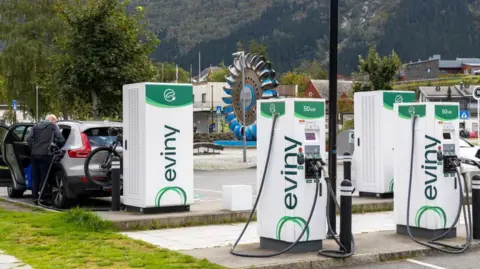Norway is in the first place to do all electricity
 BBC
BBCNorway is a world leader in the adoption of electric cars, which accounted for nine out of 10 new vehicles sold in the country last year. Can other nations learn from it?
For more than 75 years, Oslo-based car dealer Harald A. Møller has been importing Volkswagens, but as early as 2024, it will say goodbye to fossil fuel cars.
All passenger cars currently sold in his showroom are electric (EV).
“We think it’s a mistake to advise a customer coming here to buy an ICE (internal combustion engine) car because the future is electric,” CEO Ulf Tore Hackney said as he walked around the cars on display. “Long distance, high-charge speed. It’s hard to go back.”
Battery-powered cars are not new, but commonplace on the streets of Norway’s capital, Oslo. Look around and you’ll soon notice that almost every car has an “E” for “Electric” on its license plate.
The Nordic country of 5.5 million people has adopted EVs faster than any other country and is poised to become the first to end sales of new petrol cars.
Last year, the number of electric cars on Norwegian roads exceeded the number of gasoline-powered cars first time. When diesel cars are included, they account for a third of all electric cars on Norwegian roads.
And 88.9% of new cars sold in the country last year There were EVs, From 82.4% in 2023, data from the Norwegian Road Federation (OFV) shows.
In some months, sales of fully electric cars have risen by as much as 98%, as purchases of new petrol or diesel cars have almost run out.
In contrast, electric cars made in the UK Only 20% New car registrations in 2024. Although this is a high record, and increased from 16.5% in 2023.
In America, it was the number Only 8% It increased from 7.6% last year.
 Getty Images
Getty ImagesNorway is undoubtedly an EV pioneer, but this electric revolution has been three decades in the making.
“It started in the early 1990s,” says Kristina Bu, secretary general of the Norwegian EV Association, as she drives me around Oslo in an electric minivan.
Petrol and diesel cars are taxed at a lower rate, making them more expensive, while electric cars are tax-free.
The support for electric vehicles was originally launched to support two Norwegian EV pioneers, Budi (formerly Kewet) and TH!NK City. As they went out of business, incentives for green vehicles ceased.
“Our goal is to see that choosing zero emissions is always a good and worthwhile choice,” said Norway’s Deputy Transport Minister Cecilie Knibe Kröglund.
Despite being a major oil and gas producer, Norway aims to make all new cars sold “zero-emission” by 2025, starting in 2015. In 2025. A non-binding goal
“We are closing in on the target, and I think we will reach it,” Kroglud added. “I think we’ve already made the transition to passenger cars.”
She explained that the key to Norway’s success is long-term and predictable policies.
Instead of banning combustion engine vehicles, the government has guided consumer choice. In addition to penalizing fossil fuels that require higher taxes and registration fees, VAT and import duties have been rejected for low-emission cars.
A string of perks, such as free parking, reduced tolls and access to bus routes, followed.
In comparison, the EU plans to ban the sale of new petrol cars by 2035 and the current UK government wants to do the same. It will ban their sale by 2030.
The sale of petrol and diesel cars is still allowed in Norway. But few are choosing to buy them.
 Getty Images
Getty ImagesFor many locals, like Ståle Fyen, who bought his first EV 15 months ago, going electric made economic sense.
“With all the incentives we have in Norway, it was very important for us to have no tax on EVs,” he said as he plugged his car into a charging station in the capital.
“In the cold season the range is maybe 20% less, but still with the extensive charging network here in Norway this is not a big issue,” added Mr Fein. “You have to change your mindset and charge when you can, not when you want to.”
Another driver, Merete Eggesbø She said she was one of the first people to own a Tesla in Norway in 2014. “I really wanted a car that doesn’t pollute, it gave me a better conscience to drive.”
Many gas pumps at Norwegian gas stations have been replaced by fast charging points, and there are now more than 27,000 public chargers across Norway.
This is compared to 73,699 in the UK – A country 12 times larger in population.
This means that Norway has 447 chargers per 100,000 people, while the UK has just 89. According to a recent report.
Tesla, VW and Toyota were the top selling EV brands in Norway last year. Meanwhile, according to the Norwegian Road Federation, Chinese-owned brands such as MG, BID, Polestar and Xpeng – now hold about 10% of the market share.
Unlike the US and the EU, Norway has not imposed tariffs on Chinese EV imports.
 Mrs. Christina
Mrs. Christina“There’s no reason why other countries can’t copy Norway,” says Ms Bu. However, “it’s all about doing it in a way that works in each country or market,” she added.
Norwegians are no more environmentally conscious than people in other areas, she says. “I don’t think green thinking has much to do with it. It has to do with strong policies, and people are slowly realizing that it’s possible to drive an electric car.”
However, Norway is also a very wealthy country, thanks to its huge oil and gas exports, with a sovereign wealth fund worth more than $1.7 trillion (£1.3tn). This means that it can easily buy large infrastructure construction projects, and it will receive the loss of tax revenue from the sale of gasoline and diesel cars and your fuel.
The county has abundant renewable hydroelectricity, for which it is responsible. The production capacity is 88%.
“A third of cars are now electric, and in a few years it will exceed 50%,” said Kel Werner Johannes of the Norwegian Center for Transport Research. I think the government will accept that there will still be a few new petrol or hybrid cars on the market, but I don’t know anyone who wants to buy a diesel car these days.








